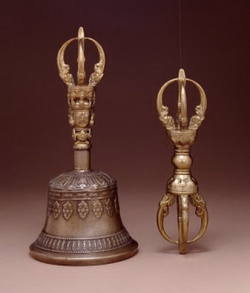Difference between revisions of "Dril-bu"
| Line 1: | Line 1: | ||
[[File:8_001_l.jpg|thumb|250px|]] | [[File:8_001_l.jpg|thumb|250px|]] | ||
| + | |||
| + | |||
| + | |||
| + | |||
| + | |||
| + | |||
| + | |||
| + | |||
[[Dril-bu]]; [[bell]] . [[Bells]], in the plural, appear as a [[meritorious]] [[offering]] which came to [[form]] a [[permanent]] fixture of the [[Buddhist]] reliquaries called [[Stūpas]]. These [[bells]], probably rather small ones equipped with cloth hangings [[attached]] to their clappers that made them ring when the [[wind]] blew, were evidently hung in strings [[attached]] to [[Stūpas]]. | [[Dril-bu]]; [[bell]] . [[Bells]], in the plural, appear as a [[meritorious]] [[offering]] which came to [[form]] a [[permanent]] fixture of the [[Buddhist]] reliquaries called [[Stūpas]]. These [[bells]], probably rather small ones equipped with cloth hangings [[attached]] to their clappers that made them ring when the [[wind]] blew, were evidently hung in strings [[attached]] to [[Stūpas]]. | ||
| Line 20: | Line 28: | ||
{{E}} | {{E}} | ||
[[Category:Dorje and Drilbu]] | [[Category:Dorje and Drilbu]] | ||
| + | [[Category:Vajra]] | ||
Latest revision as of 20:32, 4 April 2024
Dril-bu; bell . Bells, in the plural, appear as a meritorious offering which came to form a permanent fixture of the Buddhist reliquaries called Stūpas. These bells, probably rather small ones equipped with cloth hangings attached to their clappers that made them ring when the wind blew, were evidently hung in strings attached to Stūpas.
Tibetan: drilbu. Vajra handbell used in tantric practices symbolizing the all pervading wisdom-realizing emptiness.
The bell is the female part of the Tantric polarity, symbolizing emptiness - boundless openness, the space of pure wisdom and the liberating sound of the Dharma.
It is accompanied by another handheld object, a brass wand or dorje (Tibetan: diamond) - vajra in Sanskrit.
The vajra scepter is the male part of the Tantric polarity, symbolizing effective means and Buddha's active compassion.
Originally it was associated with divine authority and power as the thunderbolt weapon of the King of the gods and Lord of Storms, Indra.
In Tibet it came to represent the indestructible nature of diamond.
